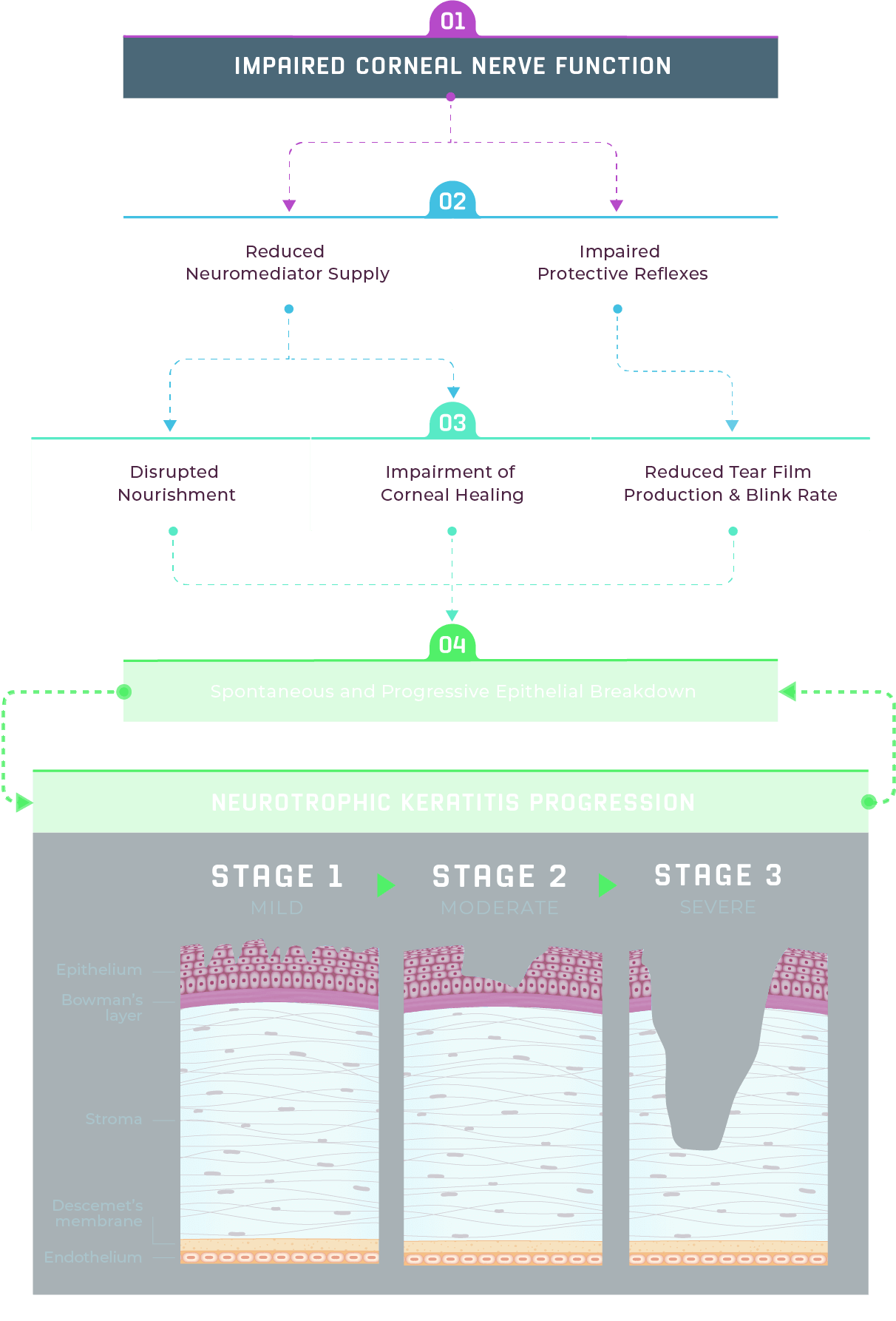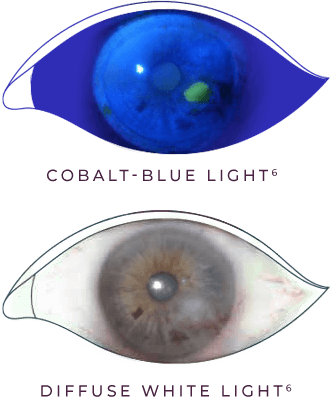
KNOW THE CONSEQUENCES OF UNDIAGNOSED NK
If left undiagnosed, neurotrophic keratitis (NK) can progress from mild to moderate to severe, and may ultimately lead to corneal perforation, stromal melting, and profound vision loss.1,2
DISEASE CASCADE
IMPAIRED CORNEAL NERVE FUNCTION SETS OFF A CASCADE OF EVENTS
Multiple etiologies can lead to impairment of the corneal nerves.2 Damage to the corneal nerves reduces the eyes’ ability to maintain ocular surface integrity.3 The loss of corneal innervation leads to a cascade of events resulting in spontaneous corneal epithelial breakdown, which ultimately leads to the progression of neurotrophic keratitis (NK).1-3

Impairment of corneal nerves prompts a series of events that cause progressive damage.3
A reduction in neuromediator supply leads to impairment of neurotrophic factors and a decreased corneal healing rate.3
Corneal nerve impairment also causes impaired protective reflexes (reduced tear film production and blink rate).3
The combination of disrupted nourishment and reduced corneal healing, tear film production, and blink rate contribute to the spontaneous breakdown of the corneal epithelium.3
Spontaneous corneal epithelial breakdown leads to NK, ranging from an irregular, dry, and cloudy corneal epithelium or punctate keratitis (Stage 1), to persistent epithelial defects (Stage 2), and corneal ulcers, stromal melting, or perforation (Stage 3).1,3
Stages of NK
ASSESSING SEVERITY WITH MACKIE CLASSIFICATION
Neurotrophic keratitis (NK) staging is based on the severity of corneal epithelial and stromal involvement, ranging from superficial punctate keratopathy to persistent epithelial defects and ulcers. Mackie classification is used to categorize NK in 3 stages: mild, moderate, and severe, but some degree of reduced corneal sensitivity is present in all stages.2
Fluorescein staining is a clear way to identify severity of disease—if staining reveals significant epithelial damage and the patient does not report any ocular discomfort, it may be a sign of NK.1,2
Some degree of vision loss can occur at all stages of the disease, and, if left untreated, mild to moderate NK may progress to severe disease with the potential for further vision loss resulting from scarring and corneal perforation.2
STAGE 1 (MILD)2

STAGE 1 (MILD) is characterized by corneal epithelial changes with dry and cloudy corneal epithelium, and the presence of punctate epithelial keratitis (PEK), also described as superficial punctate keratitis (SPK) or punctate epithelial erosions (PEE).2,4,5
“STAIN WITHOUT PAIN” can be an indicator of early stage NK that may not be otherwise recognized.1,2
Images show NK in 3 different patients.
STAGE 2 (MODERATE)2

STAGE 2 (MODERATE) is characterized by recurrent and/or persistent epithelial defects (PED) with an oval or circular shape, most frequently located paracentrally on the cornea.2,4
Images show NK in 3 different patients.
STAGE 3 (SEVERE)2

STAGE 3 (SEVERE) is characterized by corneal ulcer with stromal involvement or melting that may progress to corneal perforation.2
Images show NK in 3 different patients.
References: 1. Sacchetti M, Lambiase A. Diagnosis and management of neurotrophic keratitis. Clin Ophthalmol. 2014;8:571-579. 2. Dua HS, Said DG, Messmer EM, et al. Neurotrophic keratopathy. Prog Retin Eye Res. 2018;66:107-131. 3. Mastropasqua L, Massaro-Giordano G, Nubile M, Sacchetti M. Understanding the pathogenesis of neurotrophic keratitis: the role of corneal nerves. J Cell Physiol. 2017;232(4):717-724. 4. Versura P, Giannaccare G, Pellegrini M, Sebastiani S, Campos EC. Neurotrophic keratitis: current challenges and future prospects. Eye Brain. 2018;10:37-45. 5. Roussel T, Grutzmacher R, Coster D. Patterns of superficial keratopathy. Aust J Ophthalmol. 1984;12(4):301-316. 6. Data on File. Dompé Image Library. Dompé U.S.